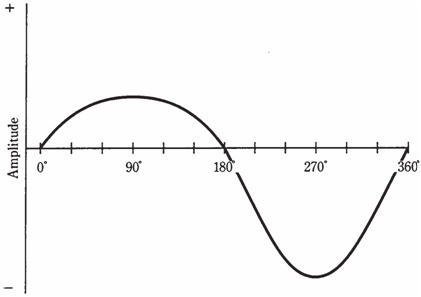Amplitude of alternating current
Amplitude is sometimes called as magnitude, level, or intensity. Depending on the quantity being measured, the magnitude of an alternating current wave might be given in amperes, volts, or watts.
Instantaneous amplitude
The instantaneous amplitude of an alternating current wave is the amplitude at some precise moment in time. This constantly changes. The method in which it varies depends on the wave form. You have seen renditions of common alternating current waveforms in this chapter. The instantaneous amplitudes are represented by the individual points on wave curves.
Peak amplitude
The peak amplitude of an alternating current wave is the maximum extent, positive or negative, which the instantaneous amplitude attains.
In many waves, the positive and negative peak amplitudes are the same. But some- times they differ. Figure given above is an example of a wave in which the positive peak amplitude is the same as the negative peak amplitude. Figure given below is an illustration of a wave which has different positive and negative peak amplitudes.

Figure-- A wave with unequal positive and negative peaks.
Peak-to-peak amplitude
The peak-to-peak amplitude of a wave is net difference between positive peak amplitude and negative peak amplitude. Another way of saying this is that peak-to-peak amplitude is equal to positive peak amplitude plus negative peak amplitude. This is a way of expressing how much wave level swings during the cycle.
In many waves, peak-to-peak amplitude is twice peak amplitude. This is case when positive and negative peak amplitudes are identical.
Root-mean-square amplitude
Often, it is necessary to express the effective level of an ac wave. This is the voltage, current or power that a direct current source would have to produce, in order to have the same effect. When you say the wall outlet has 117 V, you mean 117 volts. The most common figure for the effective alternating current levels is called as root-mean-square, or RMS, value.
For a perfect sine wave, the RMS value is equal to 0.707 times peak value, or 0.354 times peak-to-peak value. On the other hand, the peak value is 1.414 times the RMS value, and peak-to-peak value is 2.828 times the RMS value. The RMS figures are used with perfect sine waves, like the utility voltage, or the effective voltage of a radio signal.
For a perfect square wave, RMS value is the same as the peak value. The peak-to-peak value is twice RMS value or peak value.
For sawtooth and irregular waves, relationship between RMS value and peak value depends on the shape of wave. But RMS value is never more than the peak value for any waveshape.